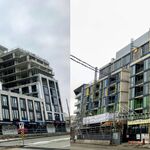jaycola
Active Member
"...But it adds that Ontario's population is expected to increase to about 15 million by 2021 – with half of the 2 million growth in the Toronto region – and more needs to be done."
When we read reports that predict Toronto and the GTA will grow in population by around 2 million citizens over the next decade and a half, we have to ask ourselves what is the best way to add such a huge number of people within the development zone and the recently created Greenbelt?
All NIMBYism aside, should we focus on increasing density within the already emerging density nodes around the GTA? Should we be looking at increased densities in suburban areas (ie duplexing and triplexing larger homes in subdivisions)? Should the focus be on the main streets already serviced with subways and Street cars? Or can the brownfields and greyfields provide the answer?
I'd like to see the suburbs get a lot denser. Replacing a couple of older detached bungalows with a row of townhomes or a lowrise multiplex. Maybe breaking up some of the monster homes in North Toronto into a few units would be a good idea?
Thoughts?
When we read reports that predict Toronto and the GTA will grow in population by around 2 million citizens over the next decade and a half, we have to ask ourselves what is the best way to add such a huge number of people within the development zone and the recently created Greenbelt?
All NIMBYism aside, should we focus on increasing density within the already emerging density nodes around the GTA? Should we be looking at increased densities in suburban areas (ie duplexing and triplexing larger homes in subdivisions)? Should the focus be on the main streets already serviced with subways and Street cars? Or can the brownfields and greyfields provide the answer?
I'd like to see the suburbs get a lot denser. Replacing a couple of older detached bungalows with a row of townhomes or a lowrise multiplex. Maybe breaking up some of the monster homes in North Toronto into a few units would be a good idea?
Thoughts?




